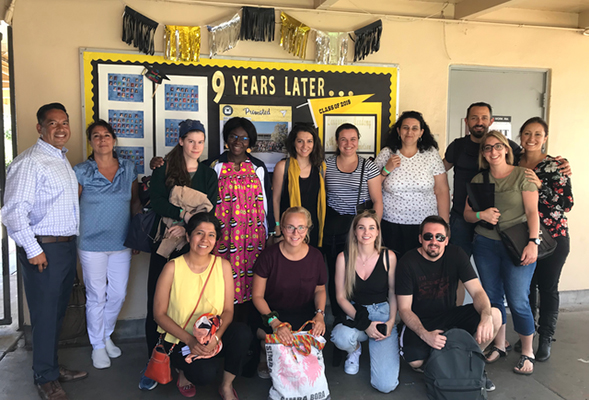Visit from Swiss Educators Speaks to Common Interests
Switzerland and California both face challenges with children who learn in more than one language, issues explored during a weeklong visit to SDSU.

One has the Alps, the other the beach. One dates to the Middle Ages, the other came of age in the 20th century postwar boom.
In many ways, Switzerland and Southern California seem a world apart. But in primary and secondary education, the prevalence of linguistically and ethnically diverse classrooms is a notable area of similarity.
This common ground brought a cohort of 11 students from University of Teacher Education, State of Vaud, Lausanne (HEP Vaud) to San Diego State University in July for a weeklong exploration of dual-language education in the San Diego region.
“The whole purpose of this research/education exchange is to help us understand each other's educational system,” said Cristina Alfaro, professor in SDSU’s Department of Dual Language and English Learner Education (DLE), which hosted the Swiss delegation. “What they're learning from us is how we deal with diversity, inclusion and equity, and how we are able to use really powerful strategies in terms of pedagogy. What we're learning from them is that it's possible to teach children several languages starting from the beginning.
“So it's an eye-opener for both."
Comparing and rethinking
Switzerland, a nation of more than eight million people in Central Europe, has four official languages — French (the primary language in Lausanne), German, Italian and Romansch, which are spoken depending on the region. Many Swiss grow up speaking three languages, often more, but increased immigration in recent decades has added speakers of other languages into classroom mix.
The Swiss contingent got a firsthand look at how California bilingual education programs educate students from non-English speaking households. They joined DLE students and faculty for presentations and seminars and visited Rosa Parks Elementary in City Heights and Language Academy, a K-8 Spanish and French immersion magnet school near SDSU. The program culminated with an excursion to Tijuana to help them better understand the realities of the border region and immigration.
“It has been extremely valuable,” said Soledad Soldevila, professor of teacher training at HEP Vaud, who led the exchange group. “Switzerland is a country where people think everything works perfectly, so people think they don't need to go abroad to see anything. I feel like you need to go abroad to question your ethics, your professional methods, everything. It's a matter of comparing and rethinking things.”
Laurie Raymond, a student at HEP Vaud who works with immigrant children in Switzerland, said she was fascinated by the bilingual education methods she witnessed on the visit.
“Before coming I had a program with students who came from Afghanistan and spoke Farsi,” Raymond said. “With some of them, our French language classes didn't succeed. Now I know that if we can teach children in their own languages (alongside French) it will improve their capability to learn French and to be integrated in Swiss society.”
Official partnership
SDSU and HEP Vaud also completed this exchange in 2011, 2012 and 2013, but the two universities signed a memorandum of understanding earlier this year to rekindle the program and make the partnership official. Both sides hope it will become an annual occurrence.
“This international partnership is a really big deal for us at San Diego State, and our department especially,” said Sera Hernandez, assistant professor in DLE. “The value of this exchange for all stakeholders was really evident based on this really intense week that we've had together.”
Master’s and doctoral students in SDSU’s College of Education will complete the exchange with a visit to Switzerland in January, to be led by Alfaro and Hernandez.



